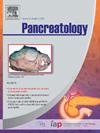Focal pancreatic parenchymal atrophy could be a precursor of pancreatic cancer
IF 2.8
2区 医学
Q2 GASTROENTEROLOGY & HEPATOLOGY
引用次数: 0
Abstract
Background/objectives
We previously reported that focal pancreatic parenchymal atrophy (FPPA) indicates high-grade pancreatic intraepithelial neoplasia (HG-PanIN) or carcinoma in situ (CIS). Because HG-PanIN progresses into pancreatic ductal adenocarcinoma (PDAC), the relationship between FPPA and PDAC should be investigated.
Methods
We included 54 patients with PDAC, whose previous computed tomography or magnetic resonance imaging were reviewed. The existence, positional relationship between FPPA and PDAC, and time between FPPA recognition and PDAC diagnosis were all examined. Of the 54 patients, 28 underwent surgery. The remaining 26 patients were histopathologically diagnosed with PDAC using endoscopic ultrasonography-guided fine needle aspiration.
Results
Among the 54 patients included, 49 (83.3 %) had FPPA. The pancreatic head and body were the common sites of FPPA. In all patients with FPPA, PDAC developed near the FPPA, with an average distance of 7.93 mm between the edge of the FPPA and the center of the PDAC. The interval between FPPA recognition and PDAC diagnosis was 35.33 months, which was significantly shorter in the surgical group.
Conclusions
FPPA could be a precursor of PDAC and suggest the area at risk of PDAC.
局灶性胰腺实质萎缩可能是胰腺癌的前兆。
背景/目的:我们之前报道过局灶性胰腺实质萎缩(FPPA)表明高级别胰腺上皮内瘤变(HG-PanIN)或原位癌(CIS)。由于HG-PanIN进展为胰腺导管腺癌(pancreatic ductal adenocarmicoma, PDAC), FPPA与PDAC之间的关系需要进一步研究。方法:我们纳入54例PDAC患者,回顾其既往的计算机断层扫描或磁共振成像。检测FPPA与PDAC的存在、位置关系、FPPA识别与PDAC诊断之间的时间。在54名患者中,有28人接受了手术。其余26例采用超声内镜引导下细针穿刺病理诊断为PDAC。结果:54例患者中49例(83.3%)行FPPA。胰头和胰体是FPPA的常见部位。在所有FPPA患者中,PDAC都发生在FPPA附近,FPPA边缘到PDAC中心的平均距离为7.93 mm。FPPA识别到PDAC诊断的时间间隔为35.33个月,手术组明显短于手术组。结论:FPPA可能是PDAC的前兆,提示PDAC的危险区域。
本文章由计算机程序翻译,如有差异,请以英文原文为准。
求助全文
约1分钟内获得全文
求助全文
来源期刊

Pancreatology
医学-胃肠肝病学
CiteScore
7.20
自引率
5.60%
发文量
194
审稿时长
44 days
期刊介绍:
Pancreatology is the official journal of the International Association of Pancreatology (IAP), the European Pancreatic Club (EPC) and several national societies and study groups around the world. Dedicated to the understanding and treatment of exocrine as well as endocrine pancreatic disease, this multidisciplinary periodical publishes original basic, translational and clinical pancreatic research from a range of fields including gastroenterology, oncology, surgery, pharmacology, cellular and molecular biology as well as endocrinology, immunology and epidemiology. Readers can expect to gain new insights into pancreatic physiology and into the pathogenesis, diagnosis, therapeutic approaches and prognosis of pancreatic diseases. The journal features original articles, case reports, consensus guidelines and topical, cutting edge reviews, thus representing a source of valuable, novel information for clinical and basic researchers alike.
 求助内容:
求助内容: 应助结果提醒方式:
应助结果提醒方式:


